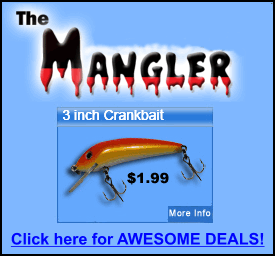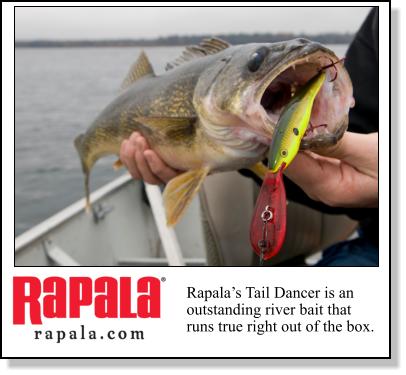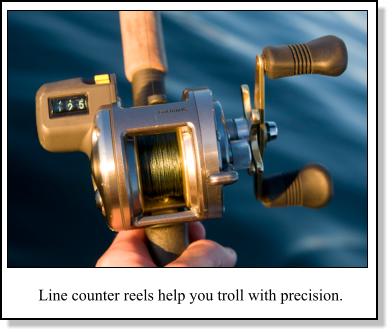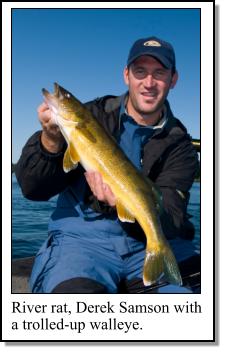|
  Walleye
Current Trolling Secrets Walleye
Current Trolling Secrets
by Tim
Allard
Without question trolling crankbaits is a consistent walleye tactic
from spring to autumn in rivers. Fast flow poses challenges, but
with the right tools and methods these hurdles are easily overcome.
The reward: lots of overlooked, willing-to-bite walleye.
Reliable River Obstructions
Classic walleye structures will hold fish on rivers. Islands around
deep water and shoreline points rarely disappoint as they obstruct
water flow and create current breaks. A hydro dam releasing water, a
wing dam and a bridge are other zones that create current anomalies
and regularly concentrate walleye in rivers.
Fish activity levels will influence their whereabouts. Inactive fish
will seek refuge from fast water. They may be belly to bottom among
boulders, in a deep hole, or hiding in weedy bays. Contrastingly,
active fish have no qualms swimming in current if itís a hunting
advantage, such as invading the top of underwater points, bars, and
shallow sand flats.
 Crankbait
Considerations Crankbait
Considerations
Proven river baits include: Rapala Tail Dancer, Minnow Rap, and
Trolls-to-Minnow, Storm Lures Deep Thunderstick, Bomber Deep Long A,
and Yo-Zuri Crystal Minnow Deep Diver.
Always test a crankbait at boat side to verify itís running
straight. If it isnít, tune the lure by bending the line tie in the
opposite direction than the baitís pulling. A boat side test will
also give clues on how certain lures perform in current at different
trolling speeds.
Planning the Attack
Unless you already know the river intimately, do some reconnaissance
before trolling. Drive over the areas you plan to fish while
watching the electronics for fish signals. Mark fish concentrations,
promising-looking structures, and current anomalies in a GPS unit or
use landmarks to triangulate the position.

Current Trolling Runs
Once you plot a trolling run and understand the areaís current
dynamics, itís time to start fishing. Generally, itís best to troll
lures upstream into the current. This gives you more control over
boat position and trolling speed. Getting fish to bite demands
precise bait placement in the sweet spot where fast and slack water
meet, so begin a distance downstream of the prime zone to give
yourself enough time to position the boat.
Gear Tips
A line counter reel helps troll crankbaits in current with
precision. Tracking line lets you run a lure at a specific depth
where fish are holding and then repeat the fish-catching formula on
each trolling pass.
 Many
anglers today are using moderate action rods combined with superline
for trolling current. No-stretch superline might seem
counterintuitive with a horizontal presentation, but it delivers the
sensitivity needed to feel the crankbaitís action in a way that
monofilament canít in fast current. This lets you know if the lureís
running true and when a bait's fouled. The latter happens often in
rivers where floating plants and wood often catch on a bait
rendering it ineffective. Many
anglers today are using moderate action rods combined with superline
for trolling current. No-stretch superline might seem
counterintuitive with a horizontal presentation, but it delivers the
sensitivity needed to feel the crankbaitís action in a way that
monofilament canít in fast current. This lets you know if the lureís
running true and when a bait's fouled. The latter happens often in
rivers where floating plants and wood often catch on a bait
rendering it ineffective.
As many veteran river anglers will attest, crankbaits are proven
producers when it comes to plying current for walleye. Tie one on,
tune it up, and hold on tight the next time you troll a river.
*Tim Allard of Ottawa, Ontario is a hard-water expert and
author-photographer of the newly released book, Ice Fishing: The
Ultimate Guide. For information visit:
www.helipress.com/product/ice-fishing-138.cfm
Editors & Publishers
T.J. & Monique Quesnel
|
The
Ontario Fishing Network
E-Magazine is
published 12 times a year on or near the beginning of every month. Our
magazine is geared to any angler who enjoys fishing of any type in the
wonderfully diverse province of Ontario. Editorial Submissions: We welcome query letters,
but assume no responsibility for unsolicited materials. Subscriptions: Subscriptions are FREE of charge
and delivered via email.
You can subscribe
HERE: Privacy Policy: Unlike other publications We
NEVER make our subscribers list (your email address) available to any
other companies. Advertising: If you are interested in advertising
please email us. Circulation - 13,000 email subscribers
© 2011 Due North
Marketing / Ontario Fishing Network / T.J. Quesnel. All rights
reserved. Reproduction of any material without prior written
permission strictly prohibited. |
|